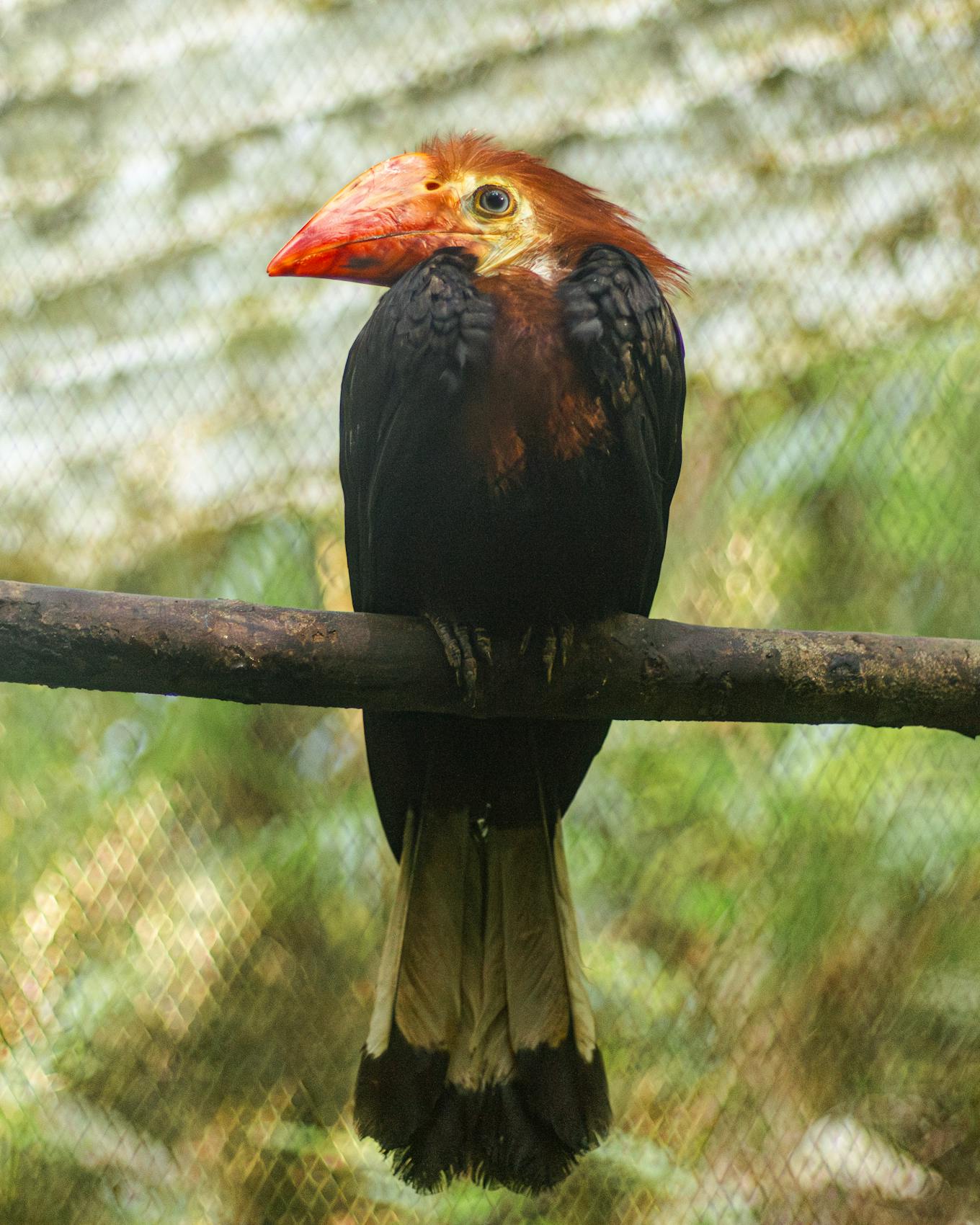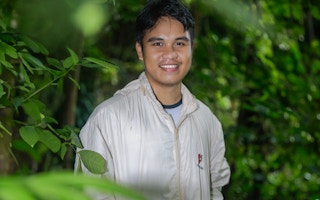“It’s really a different feeling when you see it in person. The photos can’t justify how magnificent the Rufous-headed hornbill is,” said Jann Vinze ‘Javie’ Barcinal on his first sighting of the elusive but iconic bird.
To continue reading, subscribe to Eco‑Business.
There's something for everyone. We offer a range of subscription plans.
- Access our stories and receive our Insights Weekly newsletter with the free EB Member plan.
- Unlock unlimited access to our content and archive with EB Circle.
- Publish your content with EB Premium.
The Rufous-headed hornbill (Rhabdotorrhinus waldeni) or the Dulungan Hornbill is critically endangered and only found in the rainforests of the Philippine islands of Panay and Negros. Barcinal explains that they are considered “farmers of the forest” – these birds disperse seeds throughout the forest floor as they look for fruits to feed on, despite being omnivores.
The young nature conservationist told Eco-Business he grew up listening to mythologies and folklore closely intertwined with the natural surroundings, and believes that the stories not only helped him deeply connect with nature but also gave him the urge to protect the ecosystems that shaped them. In July 2019, he founded the grassroots organisation Dulungan Youth in Antique, one of the four provinces on Panay, to promote environmental consciousness among young people and spearhead community-led conservation of the hornbill.
Based on recent data by conservation group Birdlife International, only 1,000 to 2,499 individuals of the Dulungan Hornbill remain in the wild, and they are threatened by illegal logging and poaching. Under the Republic Act No. 9147 or the Wildlife Resources Conservation and Protection Act in the Philippines, poaching and entering protected areas for exploitative activities are illegal. However, a lot of people do not even know of the hornbill’s importance, despite it being recognised as the provincial bird of Antique.

Jann teaches hornbill conservation through creative storytelling in one of Dulungan Youth’s workshops. This session was held in a classroom in Magsaysay, Culasi, Antique province. Image: Dulungan Youth.
Most recently, Dulungan Youth led “Paglaum” workshops where youth participants created animation videos to explain the importance of stakeholder collaboration to protect the hornbill. Paglaum stands for hope in Cebuano, a local language in Antique province. Across five workshops from June to October 2023, Dulungan Youth inspired at least 100 local youths to act in conservation through art and ecology.
Efforts to focus on communication and creative storytelling started during the Covid-19 pandemic. In 2020, the provincial government of Antique, advised by conservation groups, declared every August – coinciding with the end of the Dulungan Hornbill’s breeding season – Dulungan Month; when Covid-19 hit and a lockdown was imposed, it felt like this would stop efforts, but Barcinal told Eco-Business the group was not deterred and decided to use the opportunity to shift its awareness campaigns to social media platforms, assisted by “work-from-home volunteers”.
Across four years, 32 community-based campaigns were held both online and in-person, and Dulungan Youth engaged with up to 1,000 people across different stakeholder groups.
In the first Dulungan Month, one of the group’s members reported on the community platform that a juvenile hornbill had been held captive as a pet in a village, and this led to the hornbill’s rescue. The display of strong community trust impressed the authorities and Dulungan Youth was invited to participate in discussions of conservation policies and projects with the local Department of Environment and Natural Resources (DENR). The rescued hornbill was rehabilitated and released into the wild after a year or two of professional care.

This juvenile Rufous-headed hornbill was saved from illegal captivity as a pet. The case was discovered and reported by Dulungan Youth during their annual Dulungan Month awareness campaigns. Image: Jann Vinze Barcinal.
For the next few years, Dulungan Youth will push for more inclusive conservation policies and decentralised conservation areas through their programmes, Barcinal shared, adding that he has secured funding to spearhead a one-year pilot in his hometown in Culasi, Antique. This will involve establishing a conservation hub and community nursery for hornbill conservation.
Barcinal told Eco-Business he wants to incentivise communities to give up their exploitative activities to maintain their alternative livelihoods in ecotourism and nursery work.
“Dulungan Youth for me is a personal movement to shift the current paradigms of conservation in Antique to become more inclusive and holistic,” he said.
Jann’s conservation efforts earned him an award in Creators of Hope – Young Heroes for Ecology in Asia Pacific by the Jesuit Conference of Asia Pacific. He is also among 10 winners aged 30 and below recognised by the Eco-Business Sustainability Leadership Youth A-List 2023 for his innovative conservation efforts to safeguard the critically endangered Rufous-headed hornbill.
In this interview, he shares more about his conservation work and his thoughts about how to help youth overcome climate anxiety.
What do you think makes Panay Island and Antique province beautiful?
Antique is known as the province where the mountains meet the sea. I can just walk for five minutes from my house and I’m already by the ocean; with a 10-minute bike ride, I’m at the foothills of the mountains. I grew up experiencing and seeing firsthand the diversity of life.
Currently, Panay Island has eight per cent forest cover remaining. Most of it is located in the Northern part of my home province in the Central Panay Mountains Key Biodiversity Area. The area is home to diverse endemic species. There are these flagship species that we call the Panay ‘big five’. Other than the Rufous-headed Hornbill, there are also the Panay Monitor Lizard, the Visayan Warty Pig, the Visayan Spotted Deer and the Rafflesia speciosa. All five can be seen in Antique, and it says a lot about how diverse and rich in wildlife this province is.
We treat this biodiversity as our cultural treasure. Beyond the protection of nature, we also want to protect our relationship and strong connection with nature.
What do you tell youth that you work with about the cultural significance and ecological value of the Rufous-headed Hornbill?
The Rufous-headed Hornbill’s name [in Hiligaynon, an Austronesian regional language spoken in the Philippines] is “dulungan”. Its direct translation is “togetherness” in English. Dulungan reflects on the importance of Antique as a whole provincial community and its cultural value. It also reflects how creative and artistic the people are because Antique has a lot of culture, and it is embedded in nature, in the mountains of Antique, in the form of mythology and folklore.
As an organisation, with Dulungan as part of our name, even if it’s unplanned, it illustrates how we prioritise the values of collaboration and collectiveness in biodiversity conservation. Because we work together, our stories in Antique are somehow interconnected in this big tapestry.
How do you feel about climate anxiety and the mental struggle that our generation faces as we endure destruction to nature, biodiversity and our communities?
During one of our Paglaum workshops, this topic came up and participants shared how they felt so hopeless, like their individual efforts cannot do much. I saw how climate anxiety was affecting the young people in Antique. Aside from typhoons, storms, forest fires and landslides that we experience a lot in Antique, young people see first-hand the ecological destruction of the forest. The environmental issue is so big and so broad. It takes a long time to see an impact on the ground [when you do conservation work] and sometimes it can be a little bit discouraging, especially at times when I’m impatient.
But that’s where hope comes into play. To see hope for a future where everything is just thriving, with humans co-existing with nature. That is why I’m also into community-led conservation — to create more collective action from that hope. So, at the very core of what I want to do is to make more avenues and spaces for young people and communities to take ownership of that hope and translate it into collective action. We know that the ecological crisis is worsening but we don’t have to approach it in fear.
How do you convince youths at Dulungan Youth and even exploitative businesses to protect the Dulungan hornbill?
We need to work together and set aside differences, and at the same time, stray away from solely capitalistic and individualistic thinking. We need to think that current issues in climate change and grassroots conservation will affect us in the long term. We need everyone’s support, not only from communities, not only from local governments but also from businesses and corporations.
The interview has been edited for brevity and clarity.
Jann Vinze Barcinal was one of 10 sustainability leaders selected for the Eco-Business A-List 2023. Read our stories on other A-List winners here.














